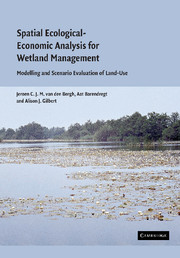 Spatial Ecological-Economic Analysis for Wetland Management
Spatial Ecological-Economic Analysis for Wetland Management Book contents
- Frontmatter
- Contents
- List of figures
- List of tables
- Preface
- 1 Introduction
- 2 Wetlands and science
- 3 Integrated modelling and assessment
- 4 Theoretical framework and method of integrated study
- 5 The Vecht area: history, problems and policy
- 6 Development scenarios for the Vecht area
- 7 The spatial–ecological model: hydrology and ecology
- 8 The spatial–economic model: agriculture, nature conservation and outdoor recreation
- 9 Performance indicators for the evaluation
- 10 Evaluation of the scenarios
- 11 Conclusions: policy and research implications
- References
- Index
8 - The spatial–economic model: agriculture, nature conservation and outdoor recreation
Published online by Cambridge University Press: 24 November 2009
- Frontmatter
- Contents
- List of figures
- List of tables
- Preface
- 1 Introduction
- 2 Wetlands and science
- 3 Integrated modelling and assessment
- 4 Theoretical framework and method of integrated study
- 5 The Vecht area: history, problems and policy
- 6 Development scenarios for the Vecht area
- 7 The spatial–ecological model: hydrology and ecology
- 8 The spatial–economic model: agriculture, nature conservation and outdoor recreation
- 9 Performance indicators for the evaluation
- 10 Evaluation of the scenarios
- 11 Conclusions: policy and research implications
- References
- Index
Summary
Introduction
This chapter looks at the changes in costs, benefits and nutrient flows under the three scenarios, as formulated in Chapter 6. The goals of this chapter are (a) to present the economic indicators, calculate these under each scenario and perform a financial cost–benefit analysis (CBA), and (b) to calculate the changes in the run-off of nutrient flows under each scenario. The economic cost and benefit indicators will be entered, along with the ecological and spatial equity indicators (Ch. 9), into the scenario evaluation (Ch. 10). Additional economic indicators, to be calculated, are the changes in net present value (NPV) and employment, and the effects of changes in the spatial and economic structure on nutrient flows. The last leads to the calculation of environmental indicators for run-off and surplus of nitrogen and phosphate, which serve as inputs to the ecosystem model discussed in Chapter 7.
There are several types of CBA. In this chapter, financial CBA indicators are generated, which means that only financial transactions are considered. Another approach is economic CBA, which also includes (social) costs and benefits for non-market goods and services, such as those related to changes in nature (Zerbe and Dively, 1994). As no prices are available for these non-market valuations, values must be estimated.
- Type
- Chapter
- Information
- Spatial Ecological-Economic Analysis for Wetland ManagementModelling and Scenario Evaluation of Land Use, pp. 129 - 161Publisher: Cambridge University PressPrint publication year: 2004


